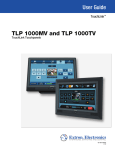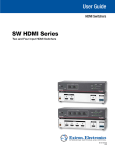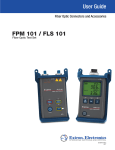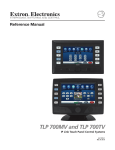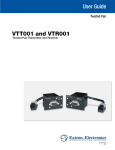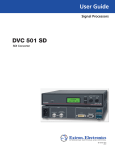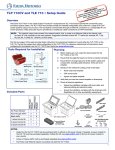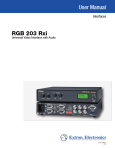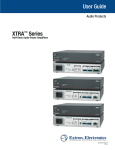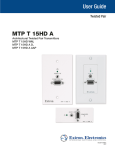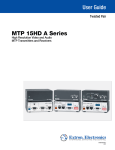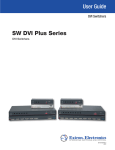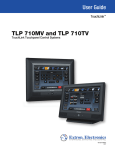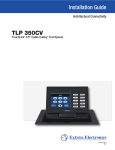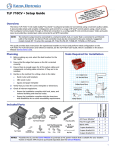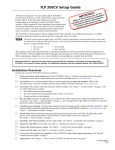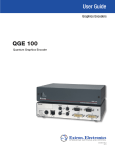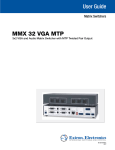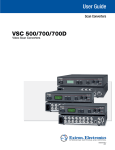Download Extron electronics TLP 710MV User guide
Transcript
User Guide TouchLink™ TLP 710CV 7" Cable Cubby® TouchLink™ Touchpanel 68-2117-01 Rev. A 12 11 Safety Instructions • English This symbol is intended to alert the user of important operating and maintenance (servicing) instructions in the literature provided with the equipment. This symbol is intended to alert the user of the presence of uninsulated dangerous voltage within the product enclosure that may present a risk of electric shock. Warning Power sources • This equipment should be operated only from the power source indicated on the product. This equipment is intended to be used with a main power system with a grounded (neutral) conductor. The third (grounding) pin is a safety feature, do not attempt to bypass or disable it. Power disconnection • To remove power from the equipment safely, remove all power cords from the rear of the equipment, or the desktop power module (if detachable), or from the power source receptacle (wall plug). Power cord protection • Power cords should be routed so that they are not likely to be stepped on or pinched by items placed upon or against them. Caution Servicing • Refer all servicing to qualified service personnel. There are no user-serviceable parts inside. To prevent the risk of shock, do not attempt to service this equipment yourself because opening or removing covers may expose you to dangerous voltage or other hazards. Retain Instructions • The safety instructions should be kept for future reference. Slots and openings • If the equipment has slots or holes in the enclosure, these are provided to prevent overheating of sensitive components inside. These openings must never be blocked by other objects. Read Instructions • Read and understand all safety and operating instructions before using the equipment. Follow Warnings • Follow all warnings and instructions marked on the equipment or in the user information. Avoid Attachments • Do not use tools or attachments that are not recommended by the equipment manufacturer because they may be hazardous. Consignes de Sécurité • Français Ce symbole sert à avertir l’utilisateur que la documentation fournie avec le matériel contient des instructions importantes concernant l’exploitation et la maintenance (réparation). Ce symbole sert à avertir l’utilisateur de la présence dans le boîtier de l’appareil de tensions dangereuses non isolées posant des risques d’électrocution. Attention Lire les instructions• Prendre connaissance de toutes les consignes de sécurité et d’exploitation avant d’utiliser le matériel. Conserver les instructions• Ranger les consignes de sécurité afin de pouvoir les consulter à l’avenir. Respecter les avertissements • Observer tous les avertissements et consignes marqués sur le matériel ou présentés dans la documentation utilisateur. Eviter les pièces de fixation • Ne pas utiliser de pièces de fixation ni d’outils non recommandés par le fabricant du matériel car cela risquerait de poser certains dangers. Sicherheitsanleitungen • Deutsch Lithium battery • There is a danger of explosion if battery is incorrectly replaced. Replace it only with the same or equivalent type recommended by the manufacturer. Dispose of used batteries according to the instructions of the manufacturer. Avertissement Alimentations • Ne faire fonctionner ce matériel qu’avec la source d’alimentation indiquée sur l’appareil. Ce matériel doit être utilisé avec une alimentation principale comportant un fil de terre (neutre). Le troisième contact (de mise à la terre) constitue un dispositif de sécurité : n’essayez pas de la contourner ni de la désactiver. Déconnexion de l’alimentation• Pour mettre le matériel hors tension sans danger, déconnectez tous les cordons d’alimentation de l’arrière de l’appareil ou du module d’alimentation de bureau (s’il est amovible) ou encore de la prise secteur. Protection du cordon d’alimentation • Acheminer les cordons d’alimentation de manière à ce que personne ne risque de marcher dessus et à ce qu’ils ne soient pas écrasés ou pincés par des objets. Réparation-maintenance • Faire exécuter toutes les interventions de réparation-maintenance par un technicien qualifié. Aucun des éléments internes ne peut être réparé par l’utilisateur. Afin d’éviter tout danger d’électrocution, l’utilisateur ne doit pas essayer de procéder lui-même à ces opérations car l’ouverture ou le retrait des couvercles risquent de l’exposer à de hautes tensions et autres dangers. Fentes et orifices • Si le boîtier de l’appareil comporte des fentes ou des orifices, ceux-ci servent à empêcher les composants internes sensibles de surchauffer. Ces ouvertures ne doivent jamais être bloquées par des objets. Lithium Batterie • Il a danger d’explosion s’il y a remplacment incorrect de la batterie. Remplacer uniquement avec une batterie du meme type ou d’un type equivalent recommande par le constructeur. Mettre au reut les batteries usagees conformement aux instructions du fabricant. Vorsicht Dieses Symbol soll dem Benutzer in der im Lieferumfang enthaltenen Dokumentation besonders wichtige Hinweise zur Bedienung und Wartung (Instandhaltung) geben. Stromquellen • Dieses Gerät sollte nur über die auf dem Produkt angegebene Stromquelle betrieben werden. Dieses Gerät wurde für eine Verwendung mit einer Hauptstromleitung mit einem geerdeten (neutralen) Leiter konzipiert. Der dritte Kontakt ist für einen Erdanschluß, und stellt eine Sicherheitsfunktion dar. Diese sollte nicht umgangen oder außer Betrieb gesetzt werden. Dieses Symbol soll den Benutzer darauf aufmerksam machen, daß im Inneren des Gehäuses dieses Produktes gefährliche Spannungen, die nicht isoliert sind und die einen elektrischen Schock verursachen können, herrschen. Stromunterbrechung • Um das Gerät auf sichere Weise vom Netz zu trennen, sollten Sie alle Netzkabel aus der Rückseite des Gerätes, aus der externen Stomversorgung (falls dies möglich ist) oder aus der Wandsteckdose ziehen. Achtung Lesen der Anleitungen • Bevor Sie das Gerät zum ersten Mal verwenden, sollten Sie alle Sicherheits-und Bedienungsanleitungen genau durchlesen und verstehen. Aufbewahren der Anleitungen • Die Hinweise zur elektrischen Sicherheit des Produktes sollten Sie aufbewahren, damit Sie im Bedarfsfall darauf zurückgreifen können. Befolgen der Warnhinweise • Befolgen Sie alle Warnhinweise und Anleitungen auf dem Gerät oder in der Benutzerdokumentation. Keine Zusatzgeräte • Verwenden Sie keine Werkzeuge oder Zusatzgeräte, die nicht ausdrücklich vom Hersteller empfohlen wurden, da diese eine Gefahrenquelle darstellen können. Instrucciones de seguridad • Español Este símbolo se utiliza para advertir al usuario sobre instrucciones importantes de operación y mantenimiento (o cambio de partes) que se desean destacar en el contenido de la documentación suministrada con los equipos. Este símbolo se utiliza para advertir al usuario sobre la presencia de elementos con voltaje peligroso sin protección aislante, que puedan encontrarse dentro de la caja o alojamiento del producto, y que puedan representar riesgo de electrocución. Precaucion Leer las instrucciones • Leer y analizar todas las instrucciones de operación y seguridad, antes de usar el equipo. Conservar las instrucciones • Conservar las instrucciones de seguridad para futura consulta. Obedecer las advertencias • Todas las advertencias e instrucciones marcadas en el equipo o en la documentación del usuario, deben ser obedecidas. Evitar el uso de accesorios • No usar herramientas o accesorios que no sean especificamente recomendados por el fabricante, ya que podrian implicar riesgos. 安全须知 • 中文 这个符号提示用户该设备用户手册中有重要的操作和维护说明。 这个符号警告用户该设备机壳内有暴露的危险电压,有触电危险。 注意 阅读说明书 保存说明书 遵守警告 • 避免追加 • • 用户使用该设备前必须阅读并理解所有安全和使用说明。 • 用 户应保存安全说明书以备将来使用。 用户应遵守产品和用户指南上的所有安全和操作说明。 不要使用该产品厂商没有推荐的工具或追加设备,以避免危险。 Schutz des Netzkabels • Netzkabel sollten stets so verlegt werden, daß sie nicht im Weg liegen und niemand darauf treten kann oder Objekte darauf- oder unmittelbar dagegengestellt werden können. Wartung • Alle Wartungsmaßnahmen sollten nur von qualifiziertem Servicepersonal durchgeführt werden. Die internen Komponenten des Gerätes sind wartungsfrei. Zur Vermeidung eines elektrischen Schocks versuchen Sie in keinem Fall, dieses Gerät selbst öffnen, da beim Entfernen der Abdeckungen die Gefahr eines elektrischen Schlags und/oder andere Gefahren bestehen. Schlitze und Öffnungen • Wenn das Gerät Schlitze oder Löcher im Gehäuse aufweist, dienen diese zur Vermeidung einer Überhitzung der empfindlichen Teile im Inneren. Diese Öffnungen dürfen niemals von anderen Objekten blockiert werden. Litium-Batterie • Explosionsgefahr, falls die Batterie nicht richtig ersetzt wird. Ersetzen Sie verbrauchte Batterien nur durch den gleichen oder einen vergleichbaren Batterietyp, der auch vom Hersteller empfohlen wird. Entsorgen Sie verbrauchte Batterien bitte gemäß den Herstelleranweisungen. Advertencia Alimentación eléctrica • Este equipo debe conectarse únicamente a la fuente/tipo de alimentación eléctrica indicada en el mismo. La alimentación eléctrica de este equipo debe provenir de un sistema de distribución general con conductor neutro a tierra. La tercera pata (puesta a tierra) es una medida de seguridad, no puentearia ni eliminaria. Desconexión de alimentación eléctrica • Para desconectar con seguridad la acometida de alimentación eléctrica al equipo, desenchufar todos los cables de alimentación en el panel trasero del equipo, o desenchufar el módulo de alimentación (si fuera independiente), o desenchufar el cable del receptáculo de la pared. Protección del cables de alimentación • Los cables de alimentación eléctrica se deben instalar en lugares donde no sean pisados ni apretados por objetos que se puedan apoyar sobre ellos. Reparaciones/mantenimiento • Solicitar siempre los servicios técnicos de personal calificado. En el interior no hay partes a las que el usuario deba acceder. Para evitar riesgo de electrocución, no intentar personalmente la reparación/mantenimiento de este equipo, ya que al abrir o extraer las tapas puede quedar expuesto a voltajes peligrosos u otros riesgos. Ranuras y aberturas • Si el equipo posee ranuras o orificios en su caja/alojamiento, es para evitar el sobrecalientamiento de componentes internos sensibles. Estas aberturas nunca se deben obstruir con otros objetos. Batería de litio • Existe riesgo de explosión si esta batería se coloca en la posición incorrecta. Cambiar esta batería únicamente con el mismo tipo (o su equivalente) recomendado por el fabricante. Desachar las baterías usadas siguiendo las instrucciones del fabricante. 警告 电源 • 该设备只能使用产品上标明的电源。 设备必须使用有地线的供电系统供电。 第三条线( 地线)是安全设施,不能不用或跳过 。 拔掉电源 • 为安全地从设备拔掉电源,请拔掉所有设备后或桌面电源的电源线,或任何接到市电 系统的电源线。 电源线保护 • 妥善布线, 避免被踩踏,或重物挤压。 维护 • 所有维修必须由认证的维修人员进行。 设备内部没有用户可以更换的零件。为避免出现触 电危险不要自己试图打开设备盖子维修该设备。 通风孔 • 有些设备机壳上有通风槽或孔,它们是用来防止机内敏感元件过热。 不要用任何东西 挡住通风孔。 锂电池 • 不正确的更换电池会有爆炸的危险。必须使用与厂家推荐的相同或相近型号的电池。按 照生产厂的建议处理废弃电池。 FCC Class A Notice This equipment has been tested and found to comply with the limits for a Class A digital device, pursuant to part 15 of the FCC Rules. Operation is subject to the following two conditions: 1. This device may not cause harmful interference. 2. This device must accept any interference received, including interference that may cause undesired operation. The Class A limits are designed to provide reasonable protection against harmful interference when the equipment is operated in a commercial environment. This equipment generates, uses, and can radiate radio frequency energy and, if not installed and used in accordance with the user guide, may cause harmful interference to radio communications. Operation of this equipment in a residential area is likely to cause harmful interference, in which case the user will be required to correct the interference at his own expense. NOTE: This unit was tested with shielded cables on the peripheral devices. Shielded cables must be used with the unit to ensure compliance with FCC emissions limits. For more information on safety guidelines, regulatory compliances, EMI/EMF compliance, accessibility, and related topics, click here. Conventions Used in this Guide In this user guide, the following are used: CAUTION: NOTE: A caution indicates a potential hazard to equipment or data. A note draws attention to important information. TIP: A tip provides a suggestion to make working with the application easier. WARNING: A warning warns of things or actions that might cause injury, death, or other severe consequences. Commands are written in the fonts shown here: ^AR Merge Scene,,Op1 scene 1,1 ^B 51 ^W^C [01] R 0004 00300 00400 00800 00600 [02] 35 [17] [03] E X! *X1& * X2) * X2# * X2! CE} NOTE: For commands and examples of computer or device responses mentioned in this guide, the character “0” is used for the number zero and “O” represents the capital letter “o.” Computer responses and directory paths that do not have variables are written in the font shown here: Reply from 208.132.180.48: bytes=32 times=2ms TTL=32 C:\Program Files\Extron Variables are written in slanted form as shown here: ping xxx.xxx.xxx.xxx —t SOH R Data STX Command ETB ETX Selectable items, such as menu names, menu options, buttons, tabs, and field names are written in the font shown here: From the File menu, select New. Click the OK button. Copyright © 2011 Extron Electronics. All rights reserved. Trademarks All trademarks mentioned in this guide are the properties of their respective owners. Contents Introduction............................................. 1 About This Guide.............................................. 1 About the TLP 710CV....................................... 1 Features............................................................ 1 Application Diagram......................................... 2 Requirements.................................................... 3 Hardware and Software................................ 3 Other Hardware............................................ 3 Installation Overview.............................. 4 Planning....................................................... 4 Mounting the TLP 710CV ............................. 4 Preparing and Installing the AAP Assembly ... 4 Connecting the Touchpanel ......................... 4 Mounting.................................................. 5 Planning........................................................... 5 Tools Required for Installation........................... 6 Included Parts................................................... 6 Cutting the Table.............................................. 7 Cutout Dimensions....................................... 7 Cutting the Surface....................................... 7 Running Cables................................................ 8 Installing Cable Retractors (Optional)................. 8 Installing the Power Modules............................ 8 Preparing and Installing the AAP Assemblies..... 9 Installing AAPs.............................................. 9 Inserting the AAP Assemblies...................... 10 Mounting the TLP 710CV Enclosure................ 11 Touchpanel Features and Connectors.... 12 Front Panel..................................................... 12 TLP 710CV Connectors................................... 14 MTP input................................................... 14 Network and Power over Ethernet Connector................................... 15 Power Connector........................................ 16 Configuration and Calibration Overview................................................. 17 Screen Configuration and Calibration............. 17 Installing Software and Firmware.................... 17 Designing the Screen Layout........................... 17 Linking Control Functions to Screen Objects ... 17 Initial Configuration and Calibration... 18 How to Access the Internal On-screen Menus........................................... 18 Main Screen.................................................... 18 Volume Screen................................................ 19 Time Screen.................................................... 20 Network Screen.............................................. 20 Video Screen................................................... 21 Touch Calibration Screen................................. 21 Configuration Software......................... 22 The Configuration Software............................ 22 Installing the Software.................................... 22 GUI Configurator and Global Configurator Installation................................................. 22 Using the TouchLink touchpanel Web Pages.... 23 Updating the Firmware................................... 25 Updating Firmware Using Extron Firmware Loader....................................................... 25 Updating Firmware Using GUI Configurator....................................... 26 Updating Firmware From a Web Browser.... 27 Using GUI Configurator.................................. 28 Using Global Configurator.............................. 33 Specifications.......................................... 38 Accessories and Part Numbers............... 42 Included Parts................................................. 42 Optional Parts................................................. 42 Reset Modes............................................ 43 TLP 710CV • Contents v TLP 710CV • Contents vi Introduction zz About This Guide zz About the TLP 710CV zz Features zz Requirements About This Guide This guide describes the function, installation, configuration, and operation of the TLP 710CV touchpanel controllers. In this guide the terms TLP 710CV and touchpanel refer to the TLP 710CV. About the TLP 710CV The Extron TLP 710CV 7-inch Cable Cubby® TouchLink™ touchpanel is fully configurable and combines the AV system control of TLP 710 touchpanels with the cable management convenience of the Cable Cubby. It features a tilt-up, full-color touchscreen in an elegant, metal enclosure that can be mounted securely into a tabletop, lectern, or other flat surface. Global Configurator and GUI Configurator software, along with ready-to-use templates, make system setup fast and easy, with no programming knowledge required. An integrated Ethernet port provides communication with IP Link® enabled control processors for controlling and monitoring AV equipment such as projectors, displays, switchers, and source devices over a standard Ethernet network. The Cable Cubby has room for 11 single Architectural Adapter Plates (AAPs). AV connectivity and cable management is provided by convenient pullout cables such as VGA, 3.5 mm audio, AV, network, HDMI, DVI, and Display port cables. Passive AAP plates and a dual AC outlet are also available. Using the video input, the touchpanel can monitor video source devices either as a preview aid or as a personal viewer for the operator. Features 7 inch LCD screen — has 800x480 resolution and displays a wide range of customizable text and graphics. Touch screen overlay — provides simple and intuitive control over a range of functions by touching on-screen icons. Video source monitoring — accepts S-video or composite video through a connection to an Extron MTP transmitter and provides a preview of the video signal. Power over Ethernet (PoE) — a twisted pair cable carries network information and 48 VDC from the PoE power supply to the touchpanel. Compatible with most Extron IP Link products — allows easy integration into existing systems. Built-in speaker — provides audible feedback when a button is pressed. TLP 710CV • Introduction 1 Light sensor — allows the auto dimming feature to adjust LCD screen backlighting to take account of ambient lighting. Lid switch — when the lid is opened the LCD screen, light sensor, and illuminating LED are all activated. When the lid is closed, these features are deactivated to save energy. The speaker is always active, whether the lid is open or closed. Sleep mode — conserves power when no button presses are detected for a user‑determined period of time. When a user touches the screen, the touchpanel is reactivated. Space for at least 11 AAPs — Provides AV connectivity through passive or pass-through AAPs. Depending on the model, there are dual AC outlets which may be US, European Union, or International. Models are also available with no AC outlets. Compatible with Extron Cable Retractors — allows cable management. Two finish options — the trim ring and lid are available in black anodized or brushed aluminium to match room decor. Application Diagram Extron TLP 710CV 7" Cable Cubby TouchLink Touchpanel Video DV D << Mor e Vide o Ex tro Mounted Through a Table or Podium n Extron RGB 580xi Interface TCP/IP Network Extron IPL 250 IP Link Ethernet Control Processor Figure 1. Typical Application for the TLP 710CV TLP 710CV • Introduction 2 Requirements Hardware and Software The latest system requirements for running the configuration software can be found on the Extron website: zz GUI Configurator zz Global Configurator Other Hardware An Extron IP Link control interface must also be connected to the same network domain as the TouchLink touchpanel. Suggested models include: zz IPL T S series (for example IPL T S4) zz IPL 250 zz IPL T CR48 zz IPL T SFI244 zz IPCP series See the Extron website (www.extron.com) for further information about these products. TLP 710CV • Introduction 3 Installation Overview This section provides an overview of the main steps required to install the TLP 710CV and provides links to more detailed explanations of each step. You can also visit the TouchLink touchpanel site at www.extron.com/touchlink for further assistance in the setup and operation of the TLP 710CV, or to enroll in online training. For additional assistance, contact your nearest Extron office. The instructions provided in this guide are for experienced installers. To avoid damaging the furniture, Extron recommends that the opening in the table for the TLP 710CV should be cut only by a licensed and bonded craftsperson. Planning Decide what the system requires and ensure that there is enough space for all the components of the system. Collect the tools needed to complete the installation. Open the shipping container and verify that all the components are present. Mounting the TLP 710CV Decide how to cut the hole and obtain the proper cutout dimensions or a router template. Cut a hole in the furniture. Preparing and Installing the AAP Assembly Run but do not connect the cables for the AAPs and TLP 710CV. Install cable retractors, if required. If required, install the power module. Install AAPs. Loosely fasten all AAPs to the AAP assembly and install cables. Install the AAP assembly into the Cable Cubby enclosure and tighten all AAPs. Mount and secure the TLP 710CV frame into the furniture opening. Connecting the Touchpanel Connect the TLP to the PoE power supply and connect the power supply to a network router. NOTE: Extron recommends using the PoE power supply (provided). Alternatively, it is possible to connect a 12 VDC power supply (not provided). (Optional) If you are not using PoE, mount and connect a 12 VDC power supply to the TLP 710CV and connect the TLP 710CV directly to a network router. (Optional) For the video monitoring capabilities, connect the MTP transmitter input. TLP 710CV • Installation Overview 4 Mounting This section provides detailed instructions for mounting the TLP 710CV in a table and installing the AAPs. It covers: zz Planning zz Tools Required for Installation zz Included Parts zz Cutting the Table zz Mounting the TLP 710CV Enclosure zz Running Cables zz Installing Cable Retractors zz Installing Power Modules zz Preparing and Installing the AAP Assemblies Planning Before making any cuts, select the best location for the TLP 710CV. Keep in mind the following: Ensure that the edge that opens on the lid is oriented correctly. Ensure there is enough space for all the system cables and components, above and below the table. Take account of: zz Clearances for under-table cabling, especially if the cable has a large bend radius. zz Adequate space below the table for cable retractors if they are to be installed. zz The number and type of AAPs required for the installation. zz The location of devices that connect to the AAPs either above or below the table. Verify that you have the correct template or dimensions. Decide on the method for cutting a hole in the table. There are three methods available: zz Hand router and template, which requires a router template (part number 70‑980‑01), which must be purchased separately zz CNC wood router, which must be programmed with the correct dimensions. zz Jigsaw, which requires a paper template (available from the Extron website). The hand router using the routing template or the CNC wood router are the most accurate methods for cutting the hole. Either one of these methods is recommended by Extron. The jigsaw is less accurate but is also acceptable. Check all relevant regulations. zz Ensure the installation complies with local, state, and national building and electrical codes. zz Ensure the installation complies with the Americans with Disabilities Act or other accessibility requirements. TLP 710CV • Mounting 5 Tools Required for Installation The following tools are required but not supplied: 1/4" Hex Nut Driver Tape Measure Square Marking Pen Phillips Screw Driver Safety Glasses Vacuum Cleaner Included Parts AM GR BE R BL EE IN N K PO PO W W ER LO ER ON AD AC ER TI RO VE R Open the shipping container and verify that all the components are present: -IN Blank AAPs LAN R LAN OUT PW Power over Ethernet (PoE) Injector AC Power Module1 AAP Shelf Bracket Kits (2 brackets/kit)2 Extro n Extron Removal Tool TLP 710CV AC Power Module 1 Pass-thru AAPs Table Clamps 1 Pos 2 Pos 3 Pos #4−40 Screws and Nuts Zip Ties With Power Module Without Power Module 1 0 3 3 Blank AAPs 6 6 1 space Bracket Kit 0 14 2 space Bracket Kit 3 4 3 space Bracket Kit 1 1 Pass-through AAPs 2,3 NOTES: 1 Outside the US, see the Extron website to purchase a power module that is suitable for your location. Each AAP Bracket Kit consists of two brackets. The rear bracket is higher than the front bracket and has two holes for screws. 2 3 4 Active or Passive AAPs are not provided and must be purchased separately (see the Extron website). Single-space brackets can only be installed in one location (see the note and figure on page 9). TLP 710CV • Mounting 6 Cutting the Table Cutout Dimensions CAUTIONS: • The table should be cut only by licensed and bonded craftspeople. • Make certain the correct cutout dimensions are being used before proceeding to the next step. Extron is not responsible for incorrectly cut mounting holes. • The surfaces of the Cable Cubby enclosure have screws and other protruding hardware that could damage fine furniture. Do not rest the enclosure on unprotected furniture. • Ensure the table surface is at least 0.375 inches (0.95 cm) thick. There are three alternative methods of making the hole for the TLP 710CV: zz If using a hand router, you should purchase the TLP 710CV routing template (part number 70-980-01). zz If using a CNC wood router, use the exact cut-out dimensions (see below). zz If using a reciprocating saw or jigsaw use the paper cut-out template. Cutting the Surface WARNING: To avoid eye injury, wear safety glasses when operating power equipment. Be certain the cut is laid out in exactly the desired location and the edge that opens on the lid is correctly oriented. After verifying and checking dimensions, cut a hole in the surface of the furniture where the enclosure will be installed. Router with Routing Template If using a routing template, make sure it is the correct template for the TLP 710CV (part number 70‑980‑01). For complete instructions, see the Routing Template User Guide, available at www.extron.com. NOTE: CAB LE HSA CU 20 BB 0 Y 30 0 USE H R SA 20 AC 0 CES S C USEAB LE R AC CUBB CES Y S 300 The metal router guide must be purchased separately. It is reusable and should not be discarded when the installation is complete. CNC Router If using a CNC router, enter the correct dimensions for the TLP 710CV: 8.90 +0.00/-0.02 inches W x 7.1 +0.00/-0.02 inches D 22.61 +0.00/-0.05 cm W x 18.03 +0.00/-0.05 cm D P/N/ 68 -2 04 6-0 1 R .B ev The width dimension (underlined) refers to the side with AAP access. O n V tro Ex P TL e 0C r th 71 fo te pla utC O u em tT If using a reciprocating saw or jigsaw, make sure to use the paper cutout template for the TLP 710CV. The template is available on the Extron website (www.extron.com). " 17 x 1" :1 : 1 1 k. ze ale in si sc hr s t e g in t Pa Pr no o D Reciprocating Saw or Jigsaw d. lle sta a in are be ut to t-o or ct cu . all V du ce late w 0M e pro a p th 1 e urf m n 7 th e s e te o TLP th th n e firm e m itio th . on ov o os C m ) fr p here ed e ll e 1. R ray th w sta g. 2. (g ark ure in enin M rnit ing op 3. fu be e is t th u C 4. g in R m e.) Tri lin of is e th dg cut r E ot ute o n (D NOTE: TLP 710CV • Mounting 7 Running Cables Run all cables necessary to support the AC connector, the cables stored in the cubby, and all planned AAP connectors. Run the cables below the table and through the hole that was cut in the previous step (“Cutting the Surface”). Leave enough slack in the cables to connect or route them before the cubby is installed in the table. Leave enough slack for the external power supply and to connect AV cables and the cable for PoE and LAN to the TLP 710CV. Installing Cable Retractors (Optional) Extron cable retractors retract and store extended cables in Cable Cubby systems, preventing them from tangling underneath the table. Retractor kits are available for several cable types. Up to six retractors can be installed in the TLP 710CV enclosure (three on either end). They are not provided with the TLP 710CV and must be purchased separately. The buttons on the retractors must be placed at one end of the unit and must, therefore, be the first or the last items added. For complete information and installation instructions, see the Retractors User Guide, which is available from the Extron web site (www.extron.com). Installing the Power Modules WARNINGS: • Switch off all electrical power before connecting the AC conduit to a junction box, and keep power off until installation is complete. • If the power cable is installed next to the retractors, ensure the power cable cannot get tangled in the cable retractor mechanism. CAUTION: NOTE: All electrical installation must be performed by qualified personnel in accordance with local and national electrical codes. Different countries require different power adapters. For models that do not include a power module, see the Extron website to select a power module that is suitable for your location. The power module takes up two or three AAP spaces and may be installed before or after the AAP assembly is installed or, if desired, with AAPs on either side. 1. Secure the power module into position with #4-40 Phillips head screws and star washers. WARNINGS: To ensure good electrical grounding, you must use the star washers with the screws. Secure the power module to the TLP 710CV frame with #4-40 Phillips head screws and star washers. Figure 2. Installing the power modules TLP 710CV • Mounting 8 2. Run the cable or conduit to a convenient junction box. Extron recommends the circuit be attached to a junction box that is directly wired to the main circuit. The AC power module does not have a fuse. Preparing and Installing the AAP Assemblies The AAP assembly organizes the AAPs onto a frame that can easily be inserted or removed from the TLP 710CV frame. Pass-through and blank AAP plates are provided with the TLP 710CV. Active or passive AAPs must be purchased separately. For the complete range of available AAPs, see the Extron website. If neither power modules nor cable retractors are installed, up to 11 AAPs can be accommodated. Cable retractors, if installed, occupy the space of two AAP slots. The power modules occupy the space of two (US) or three (European or Universal) AAP slots. AAP brackets are available in one-space, two-space, and three-space configurations. Decide the location of each AAP prior to assembly. Pass-through AAPs provide direct cable connection and must have the cable installed as they are being mounted on the brackets. TIP: The recommended way to install the cables and AAPs is to populate the brackets with AAP plates outside the enclosure as shown below, then install the populated AAP assemblies into the enclosure. NOTE: An extra column of AAP bracket mounting points is available for use with TLP Single-space AAP mounting brackets (part number 70-693-01). Single-space brackets will not fit in any other location. The extra column of mounting points is for installing single-space AAP brackets. Rear Brackets Front Brackets Figure 3. Preparing the AAP Assembly Installing AAPs 1. Determine how many AAPs will be used and how many front and rear brackets will be needed. The brackets come in one-space, two-space, and three-space configurations. The rear brackets are taller than the front brackets. 2. Place the AAP onto the bracket. Ensure one end of the AAP is secured to a front bracket and the other end is secured to a rear bracket. Whenever possible match the width of the front and rear brackets. NOTES: • Active, passive and pass-through AAPs can be mixed. • Cables can be attached to the active or passive AAPs after assembly. • Insert cables into each pass-through AAP before the next AAP is added. TLP 710CV • Mounting 9 3. Attach the AAP loosely to the bracket with the supplied #4-40 captive washer nuts. NOTE: At this time, captive washer nuts should be hand tightened otherwise it is difficult to attach the brackets to the frame of the TLP 710CV (see “Inserting the AAP Assemblies” below). 4. When using pass-through AAPs, ensure they are in the correct orientation with the opening in the grommet facing forward (see figure 4). 5. Insert one cable through the opening of each grommet. Cables can only be inserted into the pass-through AAP while the front edge is exposed. Securing the next AAP in place closes the opening on the previous AAP and ensures that the cable cannot escape. 6. Add AAPs until the bracket is filled. Spaces that are not required can be filled with a blank AAP. Inserting the AAP Assemblies 1. From under the table, push the first AAP assembly through the bottom of the enclosure. The holes in the rear bracket must align with the bottom row of holes on the rear face of the enclosure. If necessary, pull any pass-through cables out of the way. Phillips Head Screws (secure AAP Assembly) b A U D IO Large slot provides tool access to fasten rear brackets. assembly through a Push bottom of enclosure. R TE PU M CO down c Tighten AAP Nuts. Figure 4. Inserting the AAP Assemblies 2. Insert a long screwdriver through the large slot in the front panel and secure the rear bracket to the rear face of the enclosure with the provided #4-40 Phillips head screws. 3. Secure the front bracket to the front face of the enclosure, using the provided #4-40 Phillips head screws. TLP 710CV • Mounting 10 4. Use a hex nut wrench to tighten the AAP captive washer nuts. NOTE: When the AAP assembly was initially prepared, the nuts were hand tightened (see the previous section, “Installing AAPs”). If they are tightened more securely, at that stage, it is difficult to align the brackets with the screw holes on the enclosure. 5. Repeat steps 1 through 4 to add the next AAP assembly, until all the assemblies have been inserted into the enclosure. 6. Run cables to connect the source and output devices to the active and passive AAPs. Mounting the TLP 710CV Enclosure WARNING: The flanged edges of the trim ring are sharp. Exercise caution when the cubby is not installed in a table to prevent personal injury. CAUTION: The trim ring edges are soft and can easily be nicked or bent. Exercise caution when handling and mounting the enclosure. 1. Remove the edge grommet protecting the corners of the trim ring and the plastic film on the finished surfaces. CAUTION: Do not use isopropyl alcohol or other solvents to clean the Cable Cubby. Strong solvents will ruin some finishes. 2. Carefully lower the TLP 710CV enclosure into the hole cut in the table (see “Cutting the Table” on page 7). Ensure the trim ring is flush with the top of the table. 3. Under the table, attach the table clamp bodies (c) to the pins on each side of the TLP 710CV. If necessary, loosen the wingnuts (a) and the Phillips head screws (b). 4. When the clamps are properly seated on the pins, tighten the Phillips head screws until the clamp faces (d) are tightly secured against the bottom of the table. 5. To prevent the screws from becoming loose, secure the wingnuts against the table clamp bodies. d a c b d a b Figure 5. Mounting the TLP 710CV Enclosure TLP 710CV • Mounting 11 Touchpanel Features and Connectors This section discusses the features and connectors of the TLP 710CV touchpanel. Front Panel With the lid down, the light sensor (a in figure 7), the screen (b), and illumination LED (j) are disabled. All three activated by opening the lid. With the lid open, remove the front panel bezel, as shown in figure 6, using the Extron removal tool. Ex tro n a Insert the removal tool in the slot at one top corner and loosen the bezel away from the screen. Move the removal tool to b the second slot and loosen the bezel away from the screen. the removal tool along c Slide one side until the bezel separates from the unit. Figure 6. Removing the Bezel TLP 710CV • Touchpanel Features and Connectors 12 a b f g d c e Figure 7. TLP 710CV Front Panel with Bezel Removed a Light Sensor — mounted on top of the screen. The sensor monitors the level of ambient light and adjusts the screen brightness. b LCD screen — has a 800x480 resolution with a touch overlay. Extron software is used to design and configure a graphic user interface to display buttons, text, or icons, which have user‑defined functions associated with them. c Three MTP Signal Adjustments — available for S-video luminance gain (VID/Y), S-video chrominance gain (C), and sharpness (S). For composite video signals, the gain is controlled by the VID/Y adjustment. d Reset LED — provides feedback about the reset status when the user presses the reset button (see “Reset Modes” on page 43). e Controller Communication LED — unlit during normal operation. Blinks red if the connection to the IP Link controller is lost. f Reset Button — allows the unit to be reset in any of four different modes (see “Reset Modes” i on page 43). g Menu Button — activates the on-screen menus for calibrating the unit (see “Initial Calibration” on page 18). h Loudspeaker — provides audible feedback (see the figure to the right). i Slots — insert Extron removal tool to separate the bezel from the screen. j h j Illumination LED — lights the interior of the cable cubby compartment. TLP 710CV • Touchpanel Features and Connectors 13 TLP 710CV Connectors The rear panel of the TLP 710CV has a compartment that can be accessed from beneath the unit. This compartment contains the connectors for power, LAN and PoE, and MTP inputs to the touchpanel. k j POWER 12V 1.0A MAX LAN / PoE i MTP Figure 8. Cable connectors for TLP 710CV i MTP connector (RJ-45) j LAN/PoE k Power connector MTP input A twisted pair cable, terminated with an RJ‑45 connector, provides composite or S-video and audio input from an Extron MTP transmitter. CAUTION: Connect the MTP transmitter to the MTP socket and the network connector to the network socket. Although both use RJ-45 connectors, the MTP socket (on the right) must be connected to an MTP transmitter and the LAN/PoE socket (on the left) must be connected to a LAN. The wires on each connector use different voltages and inputting the wrong voltages into a socket will damage the TLP 710CV. TLP 710CV • Touchpanel Features and Connectors 14 Network and Power over Ethernet Connector The TLP 710CV connects to a network using a twisted pair cable, terminated with an RJ‑45 connector. Use a straight-through Ethernet cable to connect the touchpanel to a switch or router. Use a crossover cable to connect the touchpanel directly to a computer. An Extron IP Link control interface must also be connected to the same network domain. Suggested models are listed on page 3. LAN/PoE RJ-45 Port Link LED Activity LED The network port has two LEDs. The green LED lights solidly to indicate that the touchpanel is connected correctly to a network. The yellow LED flashes to indicate that data is being passed to or from the touchpanel. Extron recommends using a PoE power supply. Run a straight-through cable from the LAN‑IN connector of the power supply to a network switch or router. This cable carries network information. Run a second straight-through cable from the PWR LAN-OUT connector of the power supply to the LAN and PoE connector on the TLP 710CV. This cable carries network information and 48 VDC. Connect the IEC power cord from the power supply to a convenient 100 VAC to 240 VAC, 50‑60 Hz power source. If a 12 VDC power supply is being used (see page 16) run one straight-through cable from the LAN/PoE connector directly to a switch or router. Power over Ethernet (PoE) Power Supply PWR LAN-OUT To TLP 710CV LAN-IN To Network Switch Figure 9. Connecting the Power over Ethernet Power Supply CAUTIONS: • The TLP 710CV is intended for connection to a Power Over Ethernet circuit for intra-building use only and are considered a Network Environment 0 per IEC TR62101. • Always use a power supply supplied or specified by Extron. Use of an unauthorized power supply voids all regulatory compliance certification and may damage the supply and end product. • Extron power supplies are certified to UL/CSA 60950-1 and are classified as LPS (Limited Power Source). Use of a non-LPS or unlisted power supply will void all regulatory compliance certification. • Unless otherwise stated, the AC/DC adapters are not suitable for use in air handling spaces or in wall cavities. The power supply is to be located within the same vicinity as the Extron AV processing equipment in an ordinary location, Pollution Degree 2, secured to the equipment rack within the dedicated closet, podium or desk. Power over Ethernet (PoE) is intended for indoor use only. No part of the network that uses PoE can be routed outdoors. • The installation must always be in accordance with the applicable provisions of National Electrical Code ANSI/NFPA 70, article 75 and the Canadian Electrical Code part 1, section 16. The power supply shall not be permanently fixed to building structure or similar structure. TLP 710CV • Touchpanel Features and Connectors 15 Power Connector Connect the two pole, 3.5 mm captive screw connector from the 12 VDC, 1.0 A power supply (not provided) to the power supply socket on the rear panel. Ensure the connections have the correct polarity as shown below. NOTES: • Extron recommends using the Power over Ethernet power supply. This 12 VDC, 1.0 A power supply should only be used for setup or troubleshooting. • If both power supplies are connected to the TLP 710CV, the PoE power supply takes precedence. Power Receptacle Smooth A POWER 12V -- A MAX - Ridges A Power Supply Output Cord DC Power Cord Captive Screw Connector - Ground +12 VDC SECTION A–A AC Power Cord POWER 12V -- A MAX 3/16" (5 mm) Max. - External Power Supply (12 VDC, 1 A ) Figure 10. Power Supply Connection CAUTIONS: • Always use a power supply supplied by or specified by Extron. Use of an unauthorized power supply voids all regulatory compliance certification and may cause damage to the supply and the end product. • Unless otherwise stated, the AC/DC adapters are not suitable for use in air handling spaces or in wall cavities. The power supply is to be located within the same vicinity as the Extron AV processing equipment in an ordinary location, Pollution Degree 2, secured to the equipment rack within the dedicated closet, podium or desk. • The installation must always be in accordance with the applicable provisions of National Electrical Code ANSI/NFPA 70, article 75 and the Canadian Electrical Code part 1, section 16. The power supply shall not be permanently fixed to building structure or similar structure. NOTES: • The length of the exposed wires in the stripping process is critical. The ideal length is 3/16 inches (5 mm). Any longer and the exposed wires may touch, causing a short circuit between them. Any shorter and the wires can be easily pulled out even if tightly fastened by the captive screws. • Do not tin the wires. Tinned wire does not hold its shape and can become loose over time. TLP 710CV • Touchpanel Features and Connectors 16 Configuration and Calibration Overview By now, the TLP 710CV must be installed in a suitable place, all necessary cables securely attached, and the unit powered on. This section provides an overview of calibrating, designing the screen layout, and adding functions to the touchscreen. Screen Configuration and Calibration 1. Press the Menu button once. The Main screen opens. 2. Adjust values as required. 3. Press the appropriate button on the edge of the screen to select the Main, Volume, Time, Network, or Video menu and adjust the desired values from each menu. 4. Press the Menu button a second time to open the calibration-screen. 5. Press the square that is colored green until it turns gray and the next square turns green. When all four squares have been calibrated, the screen reopens to the Main screen. 6. Press the Exit button to save changes and leave the menus. Installing Software and Firmware You will need to install GUI Configurator (version 1.3 or later), Global Configurator (version 3.3 or later), and Firmware Loader on your computer. These programs are available on the DVD that ships with the TLP 710CV and from the Extron website. Firmware can be upgraded by downloading it to your PC from the Extron website. It can be uploaded to the touchpanel using Firmware Loader, GUI Configurator, or the Web Control pages for the touchpanel. 1. Check the Extron website to see if the firmware for the TLP 710CV has been upgraded. 2. Download the latest version to your PC and note the folder where it is saved. 3. Upload the firmware to the touchpanel by one of the available methods. Designing the Screen Layout 1. Use Extron GUI Configurator (version 1.3 or later) to design the graphical user interface that will appear on the TouchLink touchpanel (see the GUI Configurator help file for further information). 2. Upload the graphical user interface to the touchpanel. Linking Control Functions to Screen Objects Use Global Configurator to associate the touchpanel with an IP Link controller and to assign functions to the on-screen objects. TLP 710CV • Calibration and Configuration Overview 17 Initial Configuration and Calibration This section describes: zz How to Access the Internal On-screen Menus zz The Main, Volume, Time, Network, and Video screens zz The Touch Calibration Screen How to Access the Internal On-screen Menus When the TouchLink touchpanel first has power applied, the unit boots up and displays the opening screen. To access the on-screen menus, press the Menu button (see page 13). The menus open at the Main screen. There are five different screens (Main, Volume, Time, Network, and Video) that can be selected by pressing the appropriate button at the left side of the screen. There is also an Exit button at the bottom left corner of the screen. Pressing this button applies and saves any changes and leaves the menu screens. Main Screen Main Volume Sleep timer: 005 Min Down Up Auto Backlight PoE Active On Time Network Video Backlight: 073% Down Up Exit Figure 11. Main Screen Values can be changed by pressing the buttons to highlight them. Press the Down or Up buttons to adjust the values or press the Auto Backlight button to toggle between Off and On. The current setting is shown above the buttons. The sleep timer determines how long the touchpanel will be inactive before it enters Sleep mode, when the screen goes dark to save power. The time can be changed from 0 to 833 minutes. The time that is currently selected is shown above the buttons. TLP 710CV • Initial Configuration and Calibration 18 The screen may need a high level of backlighting for readability when ambient lighting is high. With low ambient lighting, the backlighting should be low. Auto Backlight provides a suitable amount of backlighting that is automatically calculated from the amount of ambient light detected by the light detector. Use the on-screen button to toggle the Auto Backlight option between Off and On. When Auto Backlight is set to Off, the Backlight control allows the backlighting to be set manually from 0 to 100 percent. NOTE: When Auto Backlight is set to On, changing the percentage of Backlight will not affect the amount of backlighting. The PoE status (active or inactive) is shown in the top right corner. Volume Screen Main Volume Time Master: 255 Down Up Click: 200 Down Up Network Sounds: 200 Video Down Up Line In: 32 Exit Down Up Figure 12. Volume Screen Press the Down or Up buttons to highlight one of the adjustable audio features. Use the same buttons to adjust the following settings: zz Master volume (between 0 and 255; default 255) sets the maximum volume for all the other sound volume settings. For example, if the master volume is set to 200 (approximately 80 percent of maximum), even when the Line In volume is set to 255 (maximum), it will only be equivalent to 80 percent of maximum. zz Click (between 0 and 255; default 200) sets the volume for audible feedback that accompanies events such as a screen button being pressed. zz Sounds (between 0 and 255; default 200) sets the volume of audio from any audio file playback. zz Line In (between 0 and 255; default 32) sets the volume of the audio signal received through the line in from an Extron MTP transmitter. TLP 710CV • Initial Configuration and Calibration 19 Time Screen Main Month: 06 Volume Down Time Hours: 13 Up Down Day: 06 Network Down Up Minutes: 32 Up Down Up Video Year: 2011 Down Up Exit Figure 13. Time Screen Use the Down or Up buttons to adjust the Month, Day, Year, Hours, and Minutes. NOTE: The Hours value uses the 24‑hour clock. For 10 am, set hours to 10; for 10 pm, set hours to 22. Network Screen Main MAC: 00-05-A6-07-3A-55 IP Address Volume 192.168.254.254 Time Network Subnet Mask 1 2 3 4 5 6 7 8 9 . 0 Clear 255.255.0.0 Video DHCP Off Exit Figure 14. Network Screen To set the IP Address or Subnet Mask, press the appropriate button. When one of the buttons is selected, an on‑screen keypad appears that allows the user to select digits between 0 and 9, “Clear,” or “.” (dot). NOTE: The factory default IP address for the TLP 710CV is 192.168.254.254 and the default subnet mask is 255.255.0.0. Consult your IT department to ensure these addresses are correctly assigned. Toggle between On and Off to enable or disable Dynamic Host Configuration Protocol (DHCP). This determines whether the unit will have a permanent IP address or will have one provided by the network, when required. The default setting is Off. TLP 710CV • Initial Configuration and Calibration 20 Video Screen Main Volume Time Network Contrast: 064 Down Up Color: 064 Down Brightness: 128 Down Up Up Tint: 128 Down Up Video Exit Figure 15. Video Screen When a video input is connected to the MTP input, the video can be previewed in the small gray rectangle on the screen. This preview allows the video properties to be adjusted. Use the Down or Up buttons to adjust: zz Contrast between 0 and 127 (default, 64) zz Color between 0 and 127 (default, 64) zz Brightness between 0 and 255 (default, 128) zz Tint between 0 and 255 (default, 128) Touch Calibration Screen After setting the Volume, Time, Network, and Video properties, press the Menu button a second time to begin calibrating the touch area of the touchpanel. + + Press and Hold Highlighted Box Until Color Changes + + Figure 16. Touch Calibration Screen Press on the green box until the color reverts to gray with a white border and a second box is highlighted. Repeat until all four boxes have been pressed and calibrated. At that point the screen automatically returns to the Main screen (see page 18). Pressing the Exit button on any of the menu screens (not available on the touch calibration screen) saves all changes and exits the calibration screens. TLP 710CV • Initial Configuration and Calibration 21 Configuration Software This section of the user guide provides information about: zz The Configuration Software zz Installing the Software zz Using the TouchLink Touchpanel Web Pages zz Updating the Firmware zz Using GUI Configurator zz Using Global Configurator The Configuration Software Create a graphical user interface (GUI) for the TouchLink touchpanel in two steps: 1. Design the layout of the text and graphics using GUI Configurator. 2. Assign functions to the text and graphics using Global Configurator. The GUI Configurator software is a Windows-based application. The interface is designed either by customizing an existing template or by designing an entirely new interface. GUI Configurator offers several templates that are designed to manage control system devices. After the GUI has been designed on a PC, the project is saved, built, and uploaded to the TouchLink touchpanel to verify what it looks like on the screen. It is then imported from the TLP unit to Global Configurator where control functions are assigned to the text and graphics in the layout. After assigning the control functions, the project is rebuilt and uploaded to the controller. These two programs provide versatility and adaptability for configuration and control of an AV system as it grows and evolves. Installing the Software GUI Configurator and Global Configurator Installation NOTE: You must use Global Configurator 3.3 or a later version and GUI Configurator 1.3 or a later version to configure the TLP 710CV. Insert the disc provided into the DVD-ROM drive of the computer. If the setup program does not start automatically, run Launch.exe from the DVD-ROM directory in Windows My Computer. Select the Software tab, locate the GUI Configurator program and click Install. Follow the on-screen instructions. By default, the Installer program creates and places the GUI Configurator program in the C:\Program Files\Extron\GUI Configurator folder. An icon may also be placed on the Windows desktop. TLP 710CV • Configuration Software 22 If required, locate the Global Configurator program on the disc or website and install that also. By default, the Installer program creates and places the Global Configurator program in the C:\Program Files\Extron\GCx.x folder, where x.x represents the version of the Global Configurator program. During installation, there is an option to place an icon on the Windows desktop. Both programs can be downloaded from the Extron website (www.extron.com). Select the Download tab and click the Software option in the sidebar at the left. Navigate to GUI Configurator or Global Configurator and click Download next to the program. Follow the on‑screen instructions to complete installation. A folder is created on the C:\ drive and an icon may be placed on the desktop. Follow the same procedures to download and install other software from the software disc or website. Using the TouchLink Touchpanel Web Pages The TouchLink touchpanel has default web pages that can be used to read and change the current settings of the touchpanel. The web pages can be accessed as follows: 1. Open your browser and type the IP address of the TLP 710CV unit into the address field. The browser opens the TouchLink touchpanel System Status web page, which is read-only and provides basic information about the model, date and time, and IP settings. Figure 17. System Status Page TLP 710CV • Configuration Software 23 2. Click the Configuration tab and select System Settings, which allows the user to modify the IP settings and the date and time settings. These correspond to the Network settings (see page 20) and Time settings (see page 20) in the on‑screen menus. Figure 18. System Settings Page 3. Selecting Passwords allows the user to set passwords for an administrator and a user. To set a password, follow the instructions at the top of the page. Figure 19. Passwords Page 4. To upgrade the firmware, select Firmware Upgrade. More detailed instructions are found in the “Updating Firmware from a Web Browser” section on page 27. TLP 710CV • Configuration Software 24 5. Click the Touchpanel tab, which allows the user to alter the touchpanel and volume settings. These correspond to the Main settings (see page 18) and Volume settings (see page 19) in the on-screen menus. Figure 20. Touchpanel Configuration Page Updating the Firmware Firmware for the touchpanel can be updated using the Extron Firmware Loader, using the TLP 710CV default web page, or using GUI Configurator. For any of these methods, your computer must be connected to the same network as the touchpanel. Before starting, consult your IT administrator and ensure that the touchpanel has a unique IP address. Updating Firmware Using Extron Firmware Loader 1. Power on a computer that is connected to the same network as the touchpanel. 2. Install the Extron Firmware Loader utility onto the computer if it is not already present. This is on the software disc that ships with unit or can be downloaded, free of charge, from the Extron website (www.extron.com). To install from the disc, insert the disc into the DVD-ROM drive of the computer and follow the same procedure as used for installing the GUI Configurator and Global Configurator programs (see page 22). To install from the Extron website (www.extron.com), select the Download tab and click the Software tab. Locate the Firmware Loader and click Download. Follow the on-screen instructions to complete installation. TLP 710CV • Configuration Software 25 3. From the same site, download the firmware for the TouchLink touchpanel. Click the Download tab on the Extron home page and select the Firmware option. Figure 21. Extron Web Page — Download Center 4. Navigate to the TLP 710CV firmware and click Download. This downloads the firmware to your computer. Note the folder in which the firmware file is saved. 5. Open the Extron Firmware Loader by clicking on the desktop icon. 6. Select TLP 710CV from the Device drop-down menu. 7. Select TCP/IP from the Connection Method drop-down menu. 8. Enter the IP address for the TLP 710CV, a Telnet port number (this will usually be 23), and a password. Click Connect. 9. In the New Firmware File “Path” pane, navigate to the file that was saved in step 4. Click the Add button. The main Firmware Loader screen opens with the TLP 710CV listed in the device pane. 10.Click Begin. The firmware transfer begins and takes approximately three minutes. When the Total Progress area shows “Completed”, select Exit from the File menu to exit Firmware Loader. Updating Firmware Using GUI Configurator 1. Set up the computer and touchpanel as described in steps 1 and 2 in the previous section (“Updating firmware using Extron Firmware Loader“). If necessary, install the Extron Firmware Loader utility onto the computer (use the same method described in “Installing the Software”). 2. Find the firmware on the Extron website and download it to your computer, as described in steps 3 and 4 in the previous section. 3. Open GUI Configurator to a new or existing project. Open the Firmware Update Manager by clicking on Firmware Update Manager... in the Tools menu. Figure 22. Opening Firmware Loader from GUI Configurator 4. The program will automatically connect to the TLP 710CV. Follow the on-screen instructions to upload the firmware. TLP 710CV • Configuration Software 26 Updating Firmware From a Web Browser 1. Power on a computer that is connected to the same network as the TLP 710CV. 2. From the Extron website (www.extron.com), download the firmware for the touchpanel. Click the Download tab on the Extron home page and select the Firmware option (see figure 20). 3. Navigate to the touchpanel firmware and click Download. 4. This downloads the firmware to your computer. Note the folder in which the firmware file is saved. 5. Open your browser and type the IP address of the TLP 710CV unit into the address box. The browser opens the TouchLink touchpanel web pages (see page 23). Figure 23. Firmware Upgrade Web Page 6. Click the Configuration tab at the top of the page and then select Firmware Upgrade from the bar on the left. 7. Use the Browse button to navigate to the firmware file that was saved in step 4 and select the appropriate firmware file. 8. Click Upload. The Touchpanel screen shows the message “Firmware Uploading... Please Wait...”. When the firmware is uploaded, the screen shows the message “Restarting...”. Once the firmware is installed, the touchpanel can be calibrated using the on‑screen menus (see page 18) or the TouchLink touchpanel web pages (see page 23). TLP 710CV • Configuration Software 27 Using GUI Configurator This section provides an overview of the GUI Configurator program. For complete information about the program, consult the GUI Configurator help file (select Contents in the Help menu or press the <F1> key while within the program). NOTE: To configure the touchpanel, use GUI Configurator version 1.3 or later. To use the GUI Configurator program, follow these instructions: 1. Double-click the desktop icon. The main screen opens behind the GUI Configurator Start Options dialog box. Figure 24. Opening GUI Configurator Figure 25. GUI Configurator Start Options Dialog Box TLP 710CV • Configuration Software 28 2. You can choose to: zz Start a New Project — Clicking OK opens a dialog box that offers a choice of project options. Figure 26. GUI Configurator New Project Dialog Box A series of icons offer you the choice of creating a project with a template or without a template and allow you to select the size and type of TouchLink touchpanel. If you are creating a project from an existing template, you can use the factory-created templates or you can select a template that you have previously created. zz Open an Existing Project — Clicking OK opens a dialog box that allows you to navigate to an existing project for modification. Figure 27. GUI Configurator Dialog Box to Open an Existing Project Navigate to the existing file and select it. A preview with information about the file appears in the pane on the right. TLP 710CV • Configuration Software 29 If you are working on the project, leave the Open as read-only box unchecked. Click Open to open the file. The project opens in GUI Configurator. zz Download an Existing Project from a Panel — Clicking OK opens a dialog box that allows you to download a file that has been uploaded to a touchpanel. Figure 28. GUI Configurator Download Project Dialog Box In the dialog box that opens, enter the IP address of the touchpanel and use the Browse button to navigate to a folder where the file will be saved. Check Open the project and Close Download Manager. Click OK. The project is downloaded to your computer and opens in GUI Configurator. TLP 710CV • Configuration Software 30 3. Depending on which option was selected in step 2, GUI Configurator opens to a new or existing project. The initial screen is divided into a series of panes offering a range of tools that can be used to design or modify the project. For full details on how to use these tools, consult the help file (in the Help menu click Contents, or press the <F1> key while within the program). Figure 29. GUI Configurator Main Screen 4. To save the project, select Save Project from the File menu. The project file is saved. If this is the first time saving the project file, the Save As dialog box appears. If the Save As dialog box appears: a. Browse for the location where the project file is to be saved. b. Enter a file name for the project. c. Click Save. TLP 710CV • Configuration Software 31 5. The project can be uploaded to one or more TouchLink touchpanels. To add a touchpanel: a. From the Project menu, select Add > Panel: Figure 30. Add a TouchLink touchpanel The Panel Manager dialog box opens: Figure 31. Panel Manager Dialog Box b. Click the Add Panel icon (shown in the figure to the right) to add a new touchpanel to the left pane. c. Highlight the name of the touchpanel in the left pane to display the properties of that touchpanel in the right pane. d. When a new touchpanel is added, it is assigned the default IP address (192.168.254.254). To change the IP address, highlight the address property in the right pane and type in the correct IP address. Update any other properties, as required. e. Repeat steps 5b - 5d to add further touchpanels, if required. 6. To upload a project to a TouchLink touchpanel: a. From the Project menu, select Upload to Selected Panels. The Build Manager dialog box opens, showing the build progress. After the build is complete, this dialog box closes and the File Upload Manager screen opens. The upload begins automatically. b. Select Close this dialog when upload completes check box in the Automatic Settings section so that the File Upload Manager screen closes automatically when the upload completes. This option can be set before or during the upload. TLP 710CV • Configuration Software 32 If this project has been uploaded to the TouchLink touchpanel before, you can choose to upload the changes that have been made to the previous version. You can also choose to upload to certain touchpanels from the list found within the Devices section of the File Upload Manager screen during the upload process. Using Global Configurator NOTE: To configure the touchpanel, use Global Configurator version 3.3 or later. This section provides an overview of the Global Configurator program. For complete information about the program, consult the Global Configurator help file (click Contents in the Help menu or press the <F1> key while within the program). This section describes how to set up Global Configurator project with an IPL 250. Setting up a project with another IP Link product is similar but you should consult the Global Configurator help file for exact information about the product you are using. 1. Double-click the GC3 desktop icon. The Global Configurator 3 Start Options box opens. Figure 32. Global Configurator 3 Start Options TLP 710CV • Configuration Software 33 2. Select Create A New Project and click OK. The dialog box closes, leaving the Project Settings screen. Figure 33. Global Configurator Project Settings 3. To configure the Project Settings: a. Enter the IP address for the IP Link controller. b. Set the Telnet and HTTP ports. Usually, the Telnet connection is port 23 and HTTP is port 80, so the default values do not need to be changed. c. If necessary, set administrator and user passwords. d. If required, set the date and time. e. Checking the Set Device as GlobalViewer Host box is optional. For more information about GlobalViewer host, see the Global Configurator help file. TLP 710CV • Configuration Software 34 4. Click OK. The Project Settings screen closes and is replaced by the Add Device dialog box: Figure 34. Global Configurator Add Device Dialog Box To see all the options, click the Advanced >>> button. The button name changes to Basic <<< (as shown in the figure above). a. Select the IP Link device from the drop-down menu. In figure 34, above, an IPL 250 controller is added. b. Enter the IP address of the IP Link control processor. The default value is 192.168.254.254, but this may have been changed. Check with your IT department to verify the address. c. Enter a display name into the text box. This is what the device will be known as in the Global Configurator project. d. Checking the Make this device a GlobalViewer Host check box is optional. e. Set the Telnet port (usually 23) and the web port (usually 80). f. If the controller is password protected, enter the password now. g. In the right pane, set up a GlobalViewer tree. For information about this, see the Global Configurator help file. TLP 710CV • Configuration Software 35 5. Click OK. The Add Device screen closes. The start-up screen, which was behind it, is now visible, showing the IP Link control processor and the available ports: Figure 35. Configuring an IP Link Device 6. Select TouchPanel Port 1. The screen shows the available options for the TouchLink touchpanel. To add the GUI Configurator project that was uploaded to the TouchLink touchpanel, click Click here to add one. Figure 36. Adding a TouchLink touchpanel TLP 710CV • Configuration Software 36 The Add TouchPanel dialog box opens. Figure 37. Add TouchPanel Dialog Box a. Ensure the TouchLink touchpanel model is selected from the drop-down menu and enter the IP address. b. Set the Telnet port (usually 23) and, if necessary, enter the password. c. Check the Import/Apply Layout box and click OK. The window now shows the GUI from the TouchLink touchpanel. Figure 38. Touchpanel GUI Loaded Onto Global Configurator 3 7. Use Global Configurator to associate functions with the screen elements designed in GUI Configurator (see the Global Configurator help file). TLP 710CV • Configuration Software 37 Specifications Display Screen type������������������������������������ Active matrix TFT color display Size������������������������������������������������ 7" (17.8 cm), measured diagonally Resolution�������������������������������������� 800x480 Dot/pixel pitch�������������������������������� 134 dpi Aspect ratio������������������������������������ Widescreen Color depth������������������������������������ 18 bit, 256k colors Transparency���������������������������������� 8 bit alpha channel Brightness�������������������������������������� 400 nits (cd/m2) Contrast����������������������������������������� 400:1 Backlight���������������������������������������� High bright LED Viewing angle�������������������������������� ±70° horizontal, +60°/-70° vertical Touch screen���������������������������������� Resistive membrane Memory SDRAM������������������������������������������ 128 MB for graphics processing 8 MB for system use Flash���������������������������������������������� 32 MB for project storage 16 MB for system use Control — Ethernet interface Ethernet control/communications port 1 RJ-45 female connector Ethernet data rate�������������������������� 10/100Base-T, half/full duplex with autodetect Ethernet protocol��������������������������� ICMP, IP, TCP (control), UDP, DHCP, Telnet Default settings������������������������������ Link speed and duplex level: autodetected IP address = 192.168.254.254 Subnet mask = 255.255.0.0 Default gateway = 0.0.0.0 DHCP = off Program control����������������������������� Extron Global Configurator 3.3 or higher GUI Configurator v1.3 or higher for Windows® Extron Simple Instruction Set (SIS™) Microsoft® Internet Explorer® ver. 6 or higher, Telnet Control — touchpanel Lid switch��������������������������������������� On/off Light sensor������������������������������������ On/off Video input — see S-video or composite video MTP transmitters or TLP VIM specifications Number/signal type������������������������ 1 S-video or composite video, as part of a set of proprietary signals Connector�������������������������������������� 1 female RJ-45 Standards��������������������������������������� NTSC, PAL TLP 710CV • Specifications 38 Audio input — see S-video or composite video MTP transmitters or TLP VIM specifications Number/signal type������������������������ 1 stereo, balanced/unbalanced, line level, as part of a set of proprietary signals Connector�������������������������������������� 1 female RJ-45 (shared with video input) Audio output Speaker output������������������������������ 1 mono, 89 dB SPL, 0.1 watt, 0.1 m, half space Frequency response������������������������ 900 Hz to 6 kHz, ±5 dB Playback format(s)�������������������������� WAV files: 8 bit PCM, mono, 8 kHz sampling General Power supply���������������������������������� External Input: 100-240 VAC, 50-60 Hz Output: PoE 802.3af compliant, 48 VDC, 0.35 A, 16.8 watts Power consumption Device������������������������������������� 9.8 watts, 48 VDC (PoE) Device and power supply��������� 13.5 watts, 120-240 VAC, 50-60 Hz Power over Ethernet (PoE) input requirements Complies with PoE 802.3af, class 3 Temperature/humidity�������������������� Storage: -22 to +158 °F (-30 to +70 °C) / 10% to 90%, noncondensing Operating: +32 to +122 °F (0 to +50 °C) / 10% to 90%, noncondensing Cooling������������������������������������������ Convection, no vents Thermal dissipation Device������������������������������������� 33.2 BTU/hr Device and power supply��������� 45.9 BTU/hr Mounting Furniture mount���������������������� With included hardware Min./max. table thickness��������������� 0.375" to 2.00" (0.95 cm to 5.08 cm) Enclosure type�������������������������������� Metal TLP 710CV • TLP 710CV • Specifications 39 Dimensions diagram examples 9.55" (242.6 mm) 9.85" (250.1 mm) 7.75" (196.9 mm) TOP VIEW 130° 4.08" (103.7 mm) 7.40" (187.9 mm) 6.56" (166.6 mm) FRONT VIEW SIDE VIEW 8.84" (224.5 mm) 7.04" (178.8 mm) 12.27" (311.5 mm) BOTTOM VIEW Enclosure dimensions CAUTION:Use the appropriate metal Extron routing template or refer to the surface cutout dimensions here before cutting a hole in the furniture or other surface. Pay special attention to the direction the unit will face; the unit's connector access side is underlined. Extron is not responsible for miscut mounting holes. Top plate (outer rim)���������������� 9.55" W x 7.75" D (24.26 cm W x 19.69 cm D) Surface cutout (inside rim)������� 8.90 +0.00/-0.02" W x 7.10 +0.00/-0.02" D (22.61 +0.00/-0.05 cm W x 18.03 +0.00/-0.05 cm D) Box (under surface)������������������ 7.40" H x 12.27" W (front/rear of unit) x 6.56" D with clamps (18.79 cm H x 31.15 cm W x 16.66 cm D with clamps TLP 710CV • TLP 710CV • Specifications 40 Product weight������������������������������� 5.8 lbs (2.6 kg) Shipping weight����������������������������� 11 lbs (5 kg) Vibration���������������������������������������� ISTA 1A in carton (International Safe Transit Association) Regulatory compliance Safety�������������������������������������� CE, c-UL, UL EMI/EMC��������������������������������� CE, C-tick, FCC Class A, ICES, VCCI Environmental�������������������������� Complies with the appropriate requirements of RoHS and WEEE. MTBF��������������������������������������������� 30,000 hours Warranty���������������������������������������� 3 years parts and labor; touchpanel display and overlay components are covered for 1 year NOTE: All nominal levels are at ±10%. NOTE: Specifications are subject to change without notice. TLP 710CV • TLP 710CV • Specifications 41 Accessories and Part Numbers Included Parts Description Part Number TLP 710CV TouchLink touchpanel 60-1175-02xx Power over Ethernet power inserter Cable cubby AC power module (with US models only) (6) Single blank AAP panel (3) Single space, 2 cable pass-through AAP panel (1) One-space AAP bracket kit (models without power module only) 70-693-01 (3) Two-space AAP bracket kit (models with power module) or (4) Two-space AAP bracket kit (models without power module) (1) Three-space AAP bracket kit Extron removal tool Extron Software Products DVD TLP 710CV Setup Guide Optional Parts Description Part Number PS 1210 C 12 VDC, 1.0 A desktop power supply with captive screw connector 70-775-01 Cable cubby AC power module (European) 70-264-01 Cable cubby AC power module (Universal) 70-657-01 The full range of cable cubby AC power modules can be found at www.extron.com Single blank AAP plate 70-090-x1 Single space, 2 cable pass-through AAP 70-636-0x IPL T S1 60-801-81 IPL T S2 60-544-81 IPL T S4 60-544-83 IPL T S6 60-544-84 IPL 250 60-1026-81 IPL T CR48 60-544-85 IPL T SFI244 60-544-86 IPCP 305 60-1072-02 IPCP 505 60-1071-02 TLP 710CV • Accessories and Part Numbers 42 Reset Modes The TLP 710CV has four reset modes that correspond to four of the five reset modes for the IP Link controllers. The modes are initiated by pressing the Reset button. To access the Reset button on the TLP 710CV, remove the faceplate. TLP 710CV Reset Mode Summary Mode Activation Reset all IP Settings Run or Stop Events Use Factory Firmware 1 NOTE: After a mode 1 reset is performed, update the TLP 710CV firmware to the latest version. Do not operate the firmware version that results from this mode reset. To use the factory default firmware, reload that version. See page 25 for details about uploading firmware. 3 4 Purpose and Notes The TLP 710CV reverts to the factory default firmware. Event scripting does not start if the TLP 710CV is powered on in this mode. All user files and settings (drivers, adjustments, IP settings, etc.) are maintained. This mode reverts to the factory default firmware version if incompatibility issues arise with user‑loaded firmware. NOTE: If you do not want to update firmware NOTE: User‑defined or you performed a mode 1 reset by mistake, cycle power to the TLP 710CV to return to the firmware version that was running before the mode 1 reset. Use the 0Q SIS command to confirm that the factory default firmware is no longer running (look for asterisks following the version number). web pages may not work correctly if using an earlier version of the firmware. Hold down the Reset button for approximately 3 seconds until the Release LED blinks once. Then release and press Reset momentarily (less than 1 second) within 1 second. This mode turns events on or off. Hold down the Reset button for approximately 6 seconds until the Release LED blinks twice (at 3 seconds and 6 seconds). Then release and press Reset momentarily (less than 1 second) within 1 second. This mode: •Enables ARP capability. •Resets the IP address to the factory default (192.168.254.254). •Resets the subnet to the factory default. •Resets the gateway address to the factory default. •Resets port mapping to the factory default. •Turns DHCP off. •Turns events off. This mode enables you to set IP address information, using ARP and the MAC address. This mode performs a complete reset to factory defaults (except the firmware). It does everything that mode 4 does and, in addition: •Removes button and touchpanel configurations. •Resets all IP options •Removes all scheduling options. •Removes and clears all files from the TLP 710CV. This mode is useful to start over with configuration and uploading. It also allows you to replace events. NOTE: Nothing happens if the momentary press does not occur within 1 second. 5 Reset to Factory Defaults Hold down the recessed Reset button while applying power to the TLP 710CV. Result Hold down the Reset button for approximately 9 seconds until the Release LED blinks three times (at 3, 6, and 9 seconds). Then release and press Reset momentarily (less than 1 second) within 1 second. NOTE: Nothing happens if the momentary press does not occur within 1 second. This mode is useful for troubleshooting. NOTE: Nothing happens if the momentary press does not occur within 1 second. TLP 710CV • Reset Modes 43 Extron Warranty Extron Electronics warrants this product against defects in materials and workmanship for a period of three years from the date of purchase; touchscreen display and overlay components are covered for 1 year. In the event of malfunction during the warranty period attributable directly to faulty workmanship and/or materials, Extron Electronics will, at its option, repair or replace said products or components, to whatever extent it shall deem necessary to restore said product to proper operating condition, provided that it is returned within the warranty period, with proof of purchase and description of malfunction to: USA, Canada, South America, and Central America: Extron Electronics 1001 East Ball Road Anaheim, CA 92805 U.S.A. Japan: Extron Electronics, Japan Kyodo Building, 16 Ichibancho Chiyoda-ku, Tokyo 102-0082 Japan Europe, Africa, and the Middle East: Extron Europe Hanzeboulevard 10 3825 PH Amersfoort The Netherlands China: Extron China 686 Ronghua Road Songjiang District Shanghai 201611 China Asia: Extron Asia 135 Joo Seng Road, #04-01 PM Industrial Bldg. Singapore 368363 Singapore Middle East: Extron Middle East Dubai Airport Free Zone F12, PO Box 293666 United Arab Emirates, Dubai This Limited Warranty does not apply if the fault has been caused by misuse, improper handling care, electrical or mechanical abuse, abnormal operating conditions, or modifications were made to the product that were not authorized by Extron. NOTE: If a product is defective, please call Extron and ask for an Application Engineer to receive an RA (Return Authorization) number. This will begin the repair process. USA: (714) 491-1500 Asia:65.6383.4400 Europe:31.33.453.4040 Japan: 81.3.3511.7655 Units must be returned insured, with shipping charges prepaid. If not insured, you assume the risk of loss or damage during shipment. Returned units must include the serial number and a description of the problem, as well as the name of the person to contact in case there are any questions. Extron Electronics makes no further warranties either expressed or implied with respect to the product and its quality, performance, merchantability, or fitness for any particular use. In no event will Extron Electronics be liable for direct, indirect, or consequential damages resulting from any defect in this product even if Extron Electronics has been advised of such damage. Please note that laws vary from state to state and country to country, and that some provisions of this warranty may not apply to you. Extron Headquarters +1.800.633.9876 (Inside USA/Canada Only) Extron USA - West Extron USA - East +1.714.491.1500+1.919.863.1794 +1.714.491.1517 FAX +1.919.863.1797 FAX Extron Europe +800.3987.6673 (Inside Europe Only) +31.33.453.4040 +31.33.453.4050 FAX Extron Asia +800.7339.8766 (Inside Asia Only) +65.6383.4400 +65.6383.4664 FAX Extron Japan +81.3.3511.7655 +81.3.3511.7656 FAX Extron China +4000.398766 Inside China Only +86.21.3760.1568 +86.21.3760.1566 FAX Extron Middle East +971.4.2991800 +971.4.2991880 FAX © 2011 Extron Electronics. All Rights Reserved. www.extron.com Extron Korea +82.2.3444.1571 +82.2.3444.1575 FAX Extron India 1800.3070.3777 Inside India Only +91-80-3055.3777 +91 80 3055 3737 FAX


















































